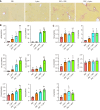Lactococcus garvieae aggravates cholestatic liver disease by increasing intestinal permeability and enhancing bile acid reabsorption
- PMID: 40093673
- PMCID: PMC11886528
- DOI: 10.3748/wjg.v31.i10.101014
Lactococcus garvieae aggravates cholestatic liver disease by increasing intestinal permeability and enhancing bile acid reabsorption
Abstract
Background: Although an association between gut microbiota and cholestatic liver disease (CLD) has been reported, the precise functional roles of these microbes in CLD pathogenesis remain largely unknown.
Aim: To explore the function of gut microbes in CLD pathogenesis and the effects of gut microbiota on intestinal barrier and bile acid (BA) metabolism in CLD.
Methods: Male C57BL/6J mice were fed a 0.05% 3,5-diethoxycarbonyl-1,4-dihydrocollidine diet for 2 weeks to induce CLD. The sterile liver tissues of mice were then meticulously harvested, and bacteria in homogenates were identified through culture methods. Furthermore, 16S ribosomal DNA sequencing was employed to analyze sterile liver samples collected from eight patients with primary biliary cholangitis (PBC) and three control individuals with hepatic cysts. The functional roles of the identified bacteria in CLD pathogenesis were assessed through microbiota transfer experiments, involving the evaluation of changes in intestinal permeability and BA dynamics.
Results: Ligilactobacillus murinus (L. murinus) and Lactococcus garvieae (L. garvieae) were isolated from the bacterial culture of livers from CLD mice. L. murinus was prevalently detected in PBC patients and controls, whereas L. garvieae was detected only in patients with PBC but not in controls. Mice inoculated with L. garvieae exhibited increased susceptibility to experimental CLD, with both in vitro and in vivo indicating that L. garvieae disrupted the intestinal barrier function by down-regulating the expression of occludin and zonula occludens-1. Moreover, L. garvieae administration significantly upregulated the expression of the apical sodium-dependent BA transporter in the terminal ileum and increased serum BA levels.
Conclusion: L. garvieae contributes to excessive BA-induced hepatobiliary injury and liver fibrosis by increasing intestinal permeability and enhancing BA reabsorption.
Keywords: Lactococcus garvieae; Bile acid; Cholestasis; Intestinal permeability; Microbiota.
©The Author(s) 2025. Published by Baishideng Publishing Group Inc. All rights reserved.
Conflict of interest statement
Conflict-of-interest statement: All the authors report no relevant conflicts of interest for this article.
Figures






References
-
- Jansen PL, Ghallab A, Vartak N, Reif R, Schaap FG, Hampe J, Hengstler JG. The ascending pathophysiology of cholestatic liver disease. Hepatology. 2017;65:722–738. - PubMed
-
- Schaap FG, Trauner M, Jansen PL. Bile acid receptors as targets for drug development. Nat Rev Gastroenterol Hepatol. 2014;11:55–67. - PubMed
-
- Griffiths L, Dyson JK, Jones DE. The new epidemiology of primary biliary cirrhosis. Semin Liver Dis. 2014;34:318–328. - PubMed
-
- Tang R, Wei Y, Li Y, Chen W, Chen H, Wang Q, Yang F, Miao Q, Xiao X, Zhang H, Lian M, Jiang X, Zhang J, Cao Q, Fan Z, Wu M, Qiu D, Fang JY, Ansari A, Gershwin ME, Ma X. Gut microbial profile is altered in primary biliary cholangitis and partially restored after UDCA therapy. Gut. 2018;67:534–541. - PubMed
-
- Chen LP, Zhao H, Lyu B, Cheng JL. [Environmental factors and primary biliary cirrhosis] Zhonghua Gan Zang Bing Za Zhi. 2016;24:541–544. - PubMed
MeSH terms
Substances
LinkOut - more resources
Full Text Sources
Molecular Biology Databases

